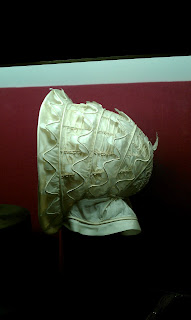~*~
Treasures of the Turku castle
We visited the castle during the medieval faire and went on the guided tour called Feast and Daily Life in the Medieval Castle. As I think I've previously mentioned, I don't own a proper camera, and the castle was rather dark, so I didn't bother taking that many pictures on the tour. I'm more of a maiden of latter eras anyway and indeed, the most interesting things to me could be found in the galleries of the renaissance floors of the castle. Not that the tour was uninteresting, but I got the most out of what the tour guide told us rather than what there was to see. Without further ado, here are a few pictures:
Linnassa oli oppaan lisäksi monia muitakin näyttelijöitä esittelemässä aikakauden puuhia. Tässä näkyy piparkakkumuotteja ja piparkakkuja. Hiukan ovat muuttuneet matkalla nykypäivään. Hienoimmat piparkakut päällystettiin lehtikullalla.
There were quite a few actors at the castle to present how things were done in the medieval times. Here a man was making gingerbread with the moulds seen on the table. They've changed quite a bit on their way to present day. The most exquisite ones were covered with gold leaf.
Korkea-arvoisimpienkaan naisten ei sopinut istuskella toimettomina. Tässä näyttelijät valmistivat kenkiä, kirjontatöitä ja lankaa. Myöhemmässä salissa trubaduurit soittivat ja tanssittivat vieraita hoviväen ja rahvaan malliin.
Even the noblest women weren't allowed to sit idly. Here the women are making shoes, embroidery and thread. In another hall, troubadours played music and made us dance, both in the way the nobility would've as well as the common folk.
Loput kuvat ovatkin näyttelytilojen puolelta. Olen aika ihastunut erilaisiin hattuihin ja olisin kovasti halunnut päästä tutkailemaan näiden rakenteita lähemminkin. Tämä on silkkitaftinen bahytti 1850-luvulta.
The rest of the pictures are from the gallery. I'm quite fond of hats, and I really would've loved to get to study the structures on these more closely. This one's silk taffeta bonnet from the 1850's.
Tästä en huomannut ottaa tietoja ylös, mutta 1800-lukua varmaan tämäkin.
I forgot to take note of where this was from, but probably the 19th century as well.
Atlassilkkinen strutsinsulkakoristeinen hattu 1880-luvulta. Tämäntapaisen olen ajatellut yrittää tehdä kunhan löydän sopivan halvan ja tukevan olkihatun sen pohjaksi.
An ostrich feather ornamented silk satin hat from 1880's. I've been thinking of making something similar as soon as I can find a study enough and cheap enough straw hat for a base.
Tässä ihastuin erityisesti tuohon sulkaperhoseen/-kolibriin. Huopahattu vuodelta 1953.
I loved the feather butterfly/hummingbird on this one. A felt hat from 1953.
Nähtävillä oli myös kokoelma hattuneuloja. Omat suosikkini olivat vasemmanpuoleisin filigraanineula sekä kolmas vasemmalta.
They also had a collection of hat pins. My personal favourites were the filigree one on the left and the third from the left.
Myös kengissä riitti ihasteltavaa. Kauppias G.W. Säven vihkikengät vuodelta 1835.
There were quite a few pairs of shoes to marvel at as well. These are the wedding shoes of the merchant G.W. Säve.
Metallilangalla kirjotut sametti- ja taftikengät vuodelta 1876.
Metal thread embroidered velvet and taffeta shoes from 1876.
Paljetein ja helmin koristellut kengät 1890-luvulta. Näistä tahtoisin jäljennökset vaikka jokapäiväiseen käyttööni, ehkä pyöreämmillä kärjillä.
Sequin and bead embellished shoes from 1890's. I'd love a replica of these for everyday wear, maybe with rounded toes.
Harmi, etten ottanut tästäkään ylös miltä vuodelta asu oli. 1800-luvun loppupuoliskoa, 1870-lukua? 1880-lukua?
I wish I'd taken note which year this dress was from. The latter half of the 19th century, 1870's? 1880's?
Tältä en nousisi koskaan. Divaani 1800-luvulta.
I'd never get up from this. A divan from the 19th century.
Keramiikkaan 1800-luvun Englannista. Vihreää jasperia ja mustaa basalttia.
Ceramics from 19th century England. Green jasper and black basalt.
Uusrokokootyylinen valokuvakehys 1800-luvun lopulta.
A photo frame from late 19th century.
People really were creative when it came to jewellery making materials in the 19th century. Here are jewellery made of the hair of the departed. I really like memento mori kind of things and these I find especially fascinating.
Nämä puolestaan on tehty kalansuomuista. Diadeemi, rannerengas ja rintaneula.
These are made of fish scales. A diadem, a bracelet and a brooch.
Nämä koristekammat ovat 1820-30-luvulta ja kilpikonnankuoresta kaiverrettuja. Ei kyllä riittäisi oma kärsivällisyyteni saati veistotaidot.
These ornamental combs are from 1820's or 30's and made of turtle shells. I'd never have the patience, nor the skill, wow.
Viimeiset esineet vieraammista materiaaleista: kivihiilikoruja 1890-luvulta, ilmeisesti näitä kutsutaan myös gagaatiksi.
The final items of stranger materials: jet jewelry from 1890's (translation slightly uncertain).
Materiaalina tuttu kulta, mutta käyttötarkoitus ei joka tytölle nykypäivänä taida olla päivänselvä. Tanssiaisohjelma 1880-luvulta. Vyölle kiinnitettävästä orvokista roikkuvat tanssivihko, kynänholkki, peili ja kukkaro.
While the material for this is familiar gold, I doubt the purpose of this is obvious to every girl nowadays. It was an accessory to be worn at balls. The violet would be attached to one's belt and off it hang a small notebook for dance reservations, a pen holder, a mirror and a small coin purse.
Hopeinen hääkruunu ja rintaneula miehelle noin vuodelta 1900. Tämä näyttäisi todella kauniilta mustilla hiuksilla...
A silver wedding crown and a groom's pin from around year 1900. This would look really beautiful on black hair...























Ei kommentteja:
Lähetä kommentti